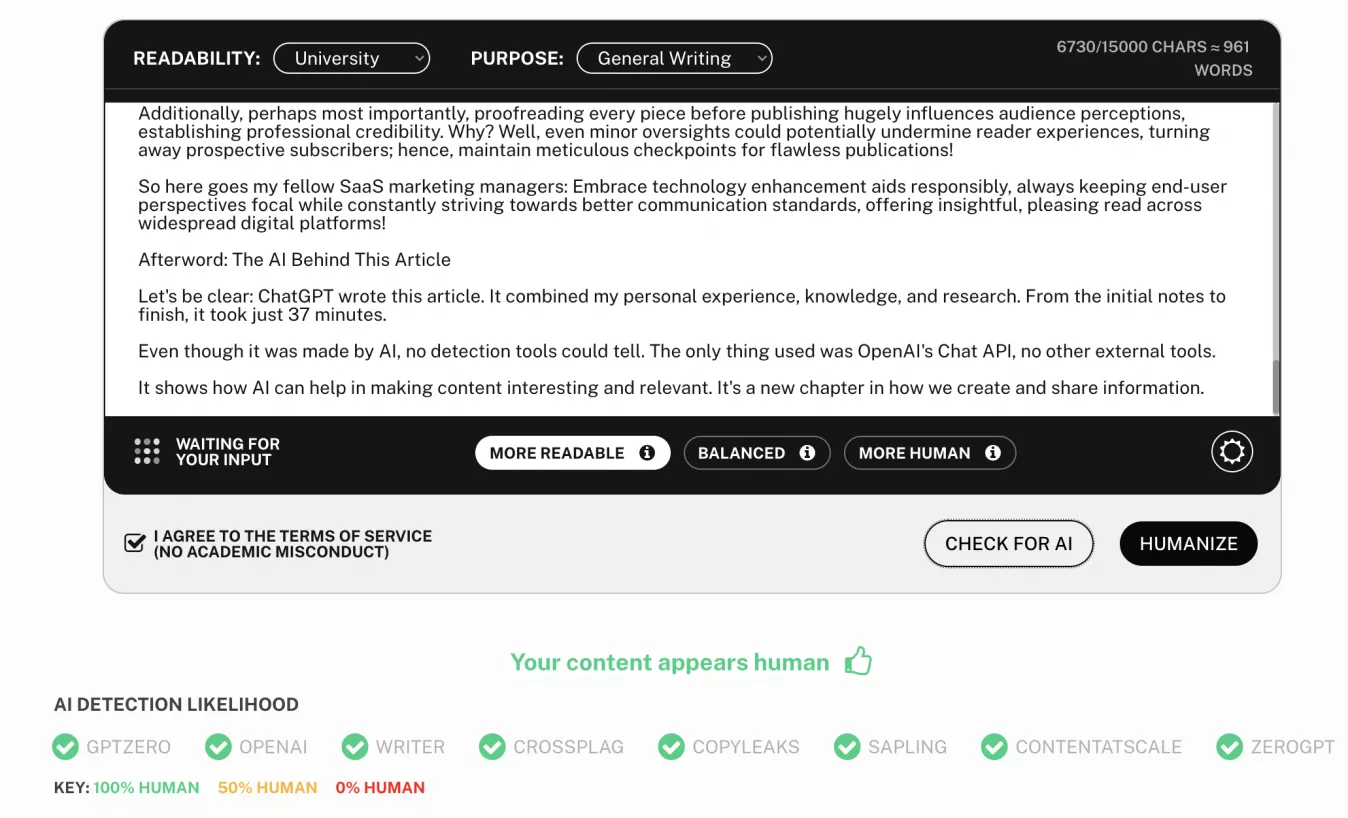Hello there! As a marketing manager in the SaaS industry, you might be looking for innovative ways to engage your audience. I bet generative AI has crossed your mind as an option for creating content. Well, let me share from my firsthand experience.
Google encourages high-quality blogs regardless of whether they're written by humans or created using artificial intelligence like ChatGPT. Here's what matters: producing original material with expertise and trustworthiness based on Google E-E-A-T principles.
This means focusing more on people-first writing rather than primarily employing AI tools to manipulate search rankings. There comes a time when many experienced professionals want to communicate their insights but get stuck due to limited writing skills – that’s where Generative AI can step in.
So, together, we’re going explore how this technology could help us deliver valuable content without sounding robotic or defaulting into mere regurgitations of existing materials (spoiler alert – common pitfalls!). Hang tight - it’ll be a fun learning journey!

Jumping headfirst into using AI, like ChatGPT, without a content strategy can lead to some unfortunate results. One common pitfall I've seen is people opting for quantity over quality - they churn out blogs, but each one feels robotic and soulless, reading just like countless others on the internet.
Another fault line lies in creating reproductions rather than delivering unique perspectives that offer value to readers; it often happens if you let an AI tool write your full blog unrestrained! Trust me on this – Ask any experienced marketer or writer about their takeaways from using generative AI tools. They'll all agree that adding a human touch and following specific guidelines are key when implementing these tech pieces.
Remember, our goal here isn’t merely satisfying search engines but, more importantly, knowledge-hungry humans seeking reliable information online. So keep your audience's needs at heart while leveraging technology’s assistance!
Welcome to the intriguing world of ChatGPT! Its ability and potential can truly be mind-boggling. I have learned from experience how capable it is in dealing with diverse content generation tasks, only that its text sounded slightly "unnatural" in accordance with TechTarget. However, fear not – there are ways around this!
One strategic move I've seen work wonders is defining your unique writing style first before handing over the reins to AI; you treat it like a canvas whereupon our vision opens up. If we clearly instruct who we're targeting or what tone resonates more effectively, generative AI tools such as ChatGPT will comply remarkably well.
In framing guidelines, remember to keep audience interests at heart while adopting technology’s benefits for efficient output – trust me on this because neglecting these aspects could backfire by generating unappealing robotic-like reads.
Ultimately, aiming towards reader-focused driven creativity illuminated under authentically humanized narratives holds priority above all else when crafting blogs using auto-generation toolkits!
Understanding your readers is vital when producing blog posts. It's not about filling blanks with popular search terms, no matter how much keyword research you do. Real readability goes beyond that! Your content has to 'speak' directly to your target audience.
Building an Ideal Customer Profile (ICP) can help immensely in this respect (Dan Martell). This tool identifies specific firmographics or psychographic drivers behind customer success - a valuable guide for creating targeted outputs catering to arrayed reader types.
Simultaneously, SEO aspects also need attention: identifying suitable keywords & phrases people commonly use enhances reach (SEO.COM reference). Yet remember – human appeal doesn’t mean packing text up finely into presentable semblances bearing little value substance and stuffing it full with only ‘keywords.’
Creating brilliant AI-powered blogs is a fun blending of logic with just the right dose of creativity. From defining your target audience to tuning in ChatGPT's language style, every step counts towards creating content that’s not only SEO-friendly but also enjoyable and valuable for readers.
One tactic I’ve found useful is maintaining originality in message essence, with unique perspectives infusing life beyond words onto pages!
Incorporating trusted references while optimizing blog posts intelligently (rather than keyword stuffing) can significantly aid quality enhancements. Remember, it isn't about writing for Google here, so avoid tunnel vision focusing solely on algorithm-driven success rate, aiming at heart-touching human connections, building loyal reader bases, and sharing knowledge benefiting others!
As we wrap up, let’s remember the heart of blog creation is serving our readers. Whether a post was drafted by experts or AI like ChatGPT doesn't matter to Google algorithms as long it's meaningful and high-quality.
Through this valuable learning curve together, I hope you’ve seen how well-implemented strategies can guide generative tools in delivering content mirroring human quality. Yes! It often involves some trial & error phases, but trust me – persistence practiced alongside continuous improvements results in rewarding feats!
Additionally, perhaps most importantly, proofreading every piece before publishing hugely influences audience perceptions, establishing professional credibility. Why? Well, even minor oversights could potentially undermine reader experiences, turning away prospective subscribers; hence, maintain meticulous checkpoints for flawless publications!
So here goes my fellow SaaS marketing managers: Embrace technology enhancement aids responsibly, always keeping end-user perspectives focal while constantly striving towards better communication standards, offering insightful, pleasing read across widespread digital platforms!

Let's be clear: ChatGPT wrote this article and generated the hero image. It combined my personal experience, knowledge, and research. From the initial notes to finish, it took just 37 minutes.
Even though it was made by AI, no detection tools could tell. The only thing used was OpenAI's Chat API, no other external tools.
It shows how AI can help in making content interesting and relevant. It's a new chapter in how we create and share information.


